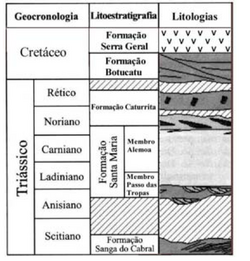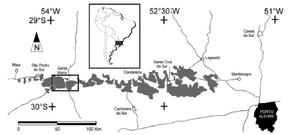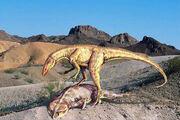 Caturrita Formation. Source: UFSM | |
| Type | Geological formation |
| Age | Carnian - Norian |
| Unit of | Santa Maria Supersequence |
| Underlies | Mata Sandstone |
| Overlies | Alemoa Member, Santa Maria Formation |
| Thickness | 30 - 60 m |
| Lithology | |
| Primary | sandstones, siltstones |
| Location | |
| Named for | Caturrita, barrio of Santa Maria
|
| Region | Geopark of Paleorrota in Rio Grande do Sul |
| Country | Brazil |
| Extent | 250 km |
| | |
The Caturrita Formation is a rock formation found in Rio Grande do Sul, Brazil. Its sediments were deposited in the Paraná Basin. The formation has a late Carnian to early Norian age (Upper Triassic) and forms part of the Santa Maria Supersequence in the upper section of the Rosário do Sul Group.
Stratigraphy[]
The sediments of the Caturrita Formation belong to the second unit of the Santa Maria Supersequence and overlie the Alemoa Member of the Santa Maria Formation. The clayey sediments of the Alemoa Member gradually give way to the more sandy, rarely conglomeratic, Caturrita Formation, which finishes with an unconformity. After this erosional event follow the Rhaetian sediments of the Mata Sandstone, the third unit of the Santa Maria Supersequence.
The Caturrita Formation was once regarded as a member of the stratigraphically higher Botucatu Formation[1] or was expanded to include the Mata Sandstone.[2]
The Caturrita Formation reaches a maximum thickness of 60 meters, but generally oscillates around values of 30 meters.
Age[]
So far no absolute ages have been determined, but the formation is assigned to a late Carnian to early Norian age on paleontological grounds, i.e. an age range of about 220 to 215 Ma.
Geographical occurrence[]
Outcrops of the Caturrita Formation are found in the Brazilian state of Rio Grande do Sul. From the town of Taquari they follow for 250 kilometers a thin band in the central part of the state in an east-westerly fashion right up to Mata.
Depositional environment[]
The sediments of the Caturrita Formation belong to the upper section of the Santa Maria Supersequence. In terms of sequence stratigraphy they are equivalent to a highstand systems tract. The scarlet, ephemeral, mainly clayey fluvio-lacustrine deposits of the Alemoa Member gradually cede to more sandy[3], occasionally gravelly deposits of a braided river-system that was operational all-year-round. These deposits of the Caturrita Formation settled out in an alluvial flood-plain. The changeover in sedimentary facies was accompanied by a climatic change to more humid conditions.[4]
The sediments are of continental nature (red beds) and form massive sandstone and siltstone bodies.[5]
Vertebrate fauna[]
The Caturrita Formation contains a biozone for tetrapods, the so-called “Ictidosauria Assemblage Zone″ Ca-1.[6]Ictidosaurs are trithelodontid cynodonts, a sister group of the mammals. This is the reason, why this biozone recently has been renamed as “Mammaliamorpha Cenozone” to underline the importance of the cynodont fossils.[7] The Caturrita Formation also hosts the stratigraphic marker level “Jachaleria”[8] named after the dicynodont Jachaleria candelariensis. Dinosaurs and other vertebrates have been discovered as well.
In 1998, tracks of prosauropods have been found near Faxinal do Soturno that were most likely caused by Unaysaurus tolentinoi.[9].
The fossil finds are concentrated around three major areas:
- Santa Maria and northern surroundings (Água Negra)
- Faxinal do Soturno
- Candelária and surroundings (Linha São Luis)
The following taxa have been discovered so far in the Caturrita Formation:
Cynodonts[]
| Cynodonts of the Caturrita Formation | ||||
|---|---|---|---|---|
| Taxa | Presence | Notes | Images | |
|
Genus:
|
||||
|
Genus:
|
||||
|
Genus: |
||||
|
Genus:
|
||||
|
Genus:
|
||||
Dicynodonts[]
| Dicynodonts of the Caturrita Formation | ||||
|---|---|---|---|---|
| Taxa | Presence | Notes | Images | |
|
Genus: |
||||
|
Genus:
|
||||
| 250px Caturrita Formation. Source: UFSM | |
| Type | Geological formation |
| Age | Carnian - Norian |
| Unit of | Santa Maria Supersequence |
| Underlies | Mata Sandstone |
| Overlies | Alemoa Member, Santa Maria Formation |
| Thickness | 30 - 60 m |
| Lithology | |
| Primary | sandstones, siltstones |
| Location | |
| Named for | Caturrita, barrio of Santa Maria
|
| Coordinates | -29.695042, -53.795403 |
| Region | Geopark of Paleorrota in Rio Grande do Sul |
| Extent | 250 km |
| | |
The Caturrita Formation is a rock formation found in Rio Grande do Sul, Brazil. Its sediments were deposited in the Paraná Basin. The formation has a late Carnian to early Norian age (Upper Triassic) and forms part of the Santa Maria Supersequence in the upper section of the Rosário do Sul Group.
Etymology[]
The formation received this name, because Caturrita is a neighbourhood (Barrio) of Santa Maria. [10] [11] In Portuguese Caturrita also designates the Monk parakeet.
Stratigraphy[]
The sediments of the Caturrita Formation belong to the second unit of the Santa Maria Supersequence and overlie the Alemoa Member of the Santa Maria Formation. The clayey sediments of the Alemoa Member gradually give way to the more sandy, rarely conglomeratic, Caturrita Formation, which finishes with an unconformity. After this erosional event follow the Rhaetian sediments of the Mata Sandstone, the third unit of the Santa Maria Supersequence.
The Caturrita Formation was once regarded as a member of the stratigraphically higher Botucatu Formation[12] or was expanded to include the Mata Sandstone.[13]
The Caturrita Formation reaches a maximum thickness of 60 meters, but generally oscillates around values of 30 meters.
Age[]
So far no absolute ages have been determined, but the formation is assigned to a late Carnian to early Norian age on paleontological grounds, i.e. an age range of about 220 to 215 million years BP.
Geographical occurrence[]
Outcrops of the Caturrita Formation are found in the Brazilian state of Rio Grande do Sul. From the town of Taquari they follow for 250 kilometers a thin band in the central part of the state in an east-westerly fashion right up to Mata.
Depositional environment[]
The sediments of the Caturrita Formation belong to the upper section of the Santa Maria Supersequence. In terms of sequence stratigraphy they are equivalent to a highstand systems tract. The scarlet, ephemeral, mainly clayey fluvio-lacustrine deposits of the Alemoa Member gradually cede to more sandy[14], occasionally gravelly deposits of a braided river-system that was operational all-year-round. These deposits of the Caturrita Formation settled out in an alluvial flood-plain. The changeover in sedimentary facies was accompanied by a climatic change to more humid conditions.[15]
The sediments are of continental nature (red beds) and form massive sandstone and siltstone bodies.[16]
Vertebrate fauna[]
The Caturrita Formation contains a biozone for tetrapods, the so-called “Ictidosauria Assemblage Zone″ Ca-1.[17]Ictidosaurs are trithelodontid cynodonts, a sister group of the mammals. This is the reason, why this biozone recently has been renamed as “Mammaliamorpha Cenozone” to underline the importance of the cynodont fossils.[18] The Caturrita Formation also hosts the stratigraphic marker level “Jachaleria”[19] named after the dicynodont Jachaleria candelariensis. Dinosaurs and other vertebrates have been discovered as well.
In 1998 tracks of prosauropods have been found near Faxinal do Soturno that were most likely caused by Unaysaurus tolentinoi.[20].
The fossil finds are concentrated around three major areas:
- Santa Maria and northern surroundings (Água Negra)
- Faxinal do Soturno
- Candelária and surroundings (Linha São Luis)
The following taxa have been discovered so far in the Caturrita Formation:
Cynodonts[]
| Cynodonts of the Caturrita Formation | ||||
|---|---|---|---|---|
| Taxa | Presence | Notes | Images | |
|
Genus:
|
||||
|
Genus:
|
||||
|
Genus: |
||||
|
Genus:
|
||||
|
Genus:
|
||||
Dicynodonts[]
| Dicynodonts of the Caturrita Formation | ||||
|---|---|---|---|---|
| Taxa | Presence | Notes | Images | |
|
Genus: |
||||
|
Genus:
|
||||
Dinosaurs[]
| Dinosaurs of the Caturrita Formation | ||||
|---|---|---|---|---|
| Taxa | Presence | Notes | Images | |
|
Genus:
|
|
Sauropod | ||
|
Genus:
|
|
Sauropod | ||
|
Genus:
|
|
Sauropod | ||
|
Genus:
|
|
Theropod | ||
|
Genus:
|
|
Sauropod | ||
|
Infraorder:
|
|
|||
Sauropsida[]
| Sauropsida of the Caturrita Formation | ||||
|---|---|---|---|---|
| Taxa | Presence | Notes | Images | |
|
Genus:
|
Sphenodontia | |||
|
Genus: |
||||
|
Genus:
|
Procolophonia | |||
|
Order:
|
||||
See also[]
References[]
- ^ Bortoluzzi, C.A. 1974. Contribuição à Geologia da Região de Santa Maria, Rio Grande do Sul, Brasil. Pesquisas, 4 (1):7-86
- ^ Andreis, R.R.; Bossi, G.E. & Montardo, D.K. 1980. O Grupo Rosário do Sul (Triássico) no Rio grande do Sul. In: CONGRESSO BRASILEIRO DE GEOLOGIA,31, Balneário 16 Camboriú, 1980. Anais... Balneário de Camboriú, SBG, v. 2, p.659-673.
- ^ Zerfass, H.; Lavina, E.L.; Schultz, C.L.; Garcia, A.J.V.; Faccini, U.F. & Chemale Jr., F. 2003. Sequence stratigraphy of continental Triassic strata of Southernmost Brazil: a contribution to Southwestern Gondwana palaeogeography and palaeoclimate. Sedimentary Geology, 161:85-105.
- ^ Holz, M. und Scherer, C.M.S., 2000, Sedimentological and paleontological evidence of paleoclimatic change during the Southbrazilian Triassic: the register of a global trend towards a humid paleoclimate: Zentralblatt für Geologie und Paläontologie, Teil I, v. 11-12, p. 1589-1609.
- ^ Rubert, R. R. & Schultz, C. L. 2004. — Um novo horizonte de correlação para o Triássico Superior do Rio Grande do Sul. Pesquisas em Geociências 31: 71-88.
- ^ Oliveira É. V. 2006. — Reevaluation of Therioherpeton cargnini Bonaparte & Barberena, 1975 (Probainognathia, Therioherpetidae) from the Upper Triassic of Brazil. Geodiversitas 28 (3) : 447-465.
- ^ Soares, M.B. & Schultz, C.L., 2006. Proposta de nova denominação para a Cenozona de Ictidosauria, do Triássico Superior (Formação Caturrita) do Rio Grande do Sul. V Simpósio Brasileiro de Paleontologia de Vertebrados, Boletim de Resumos, p. 41, Santa Maria, RS, 2006.
- ^ Schultz. C.L.; Scherer, C.M.S. & Barberena, M.C. 1994. Uma nova proposta de zoneamento estratigráfi co para o Triássico Superior Sul-Rio-Grandense. In: Congresso Brasileiro de Geologia, 38, Camboriú - SC, 1994. Boletim de Resumos, p. 107-108.
- ^ Rafael Costa Da Silva, Ismar De Souza Carvalho, Cibele Schwanke, 2006. Vertebrate dinoturbation from the Caturrita Formation (Late Triassic, Paraná Basin), Rio Grande do Sul State, Brazil. Gondwana Research 11 (2007) 303–310.
- ^ http://www.lenep.uenf.br/~severian/es-sm-sincro.html Formação Santa Maria, (in Portuguese)
- ^ http://www.pesquisasemgeociencias.ufrgs.br/arquivos/ARTIGO311.pdf Paleoformações, (in Portuguese)
- ^ Bortoluzzi, C.A. 1974. Contribuição à Geologia da Região de Santa Maria, Rio Grande do Sul, Brasil. Pesquisas, 4 (1):7-86
- ^ Andreis, R.R.; Bossi, G.E. & Montardo, D.K. 1980. O Grupo Rosário do Sul (Triássico) no Rio grande do Sul. In: CONGRESSO BRASILEIRO DE GEOLOGIA,31, Balneário 16 Camboriú, 1980. Anais... Balneário de Camboriú, SBG, v. 2, p.659-673.
- ^ Zerfass, H.; Lavina, E.L.; Schultz, C.L.; Garcia, A.J.V.; Faccini, U.F. & Chemale Jr., F. 2003. Sequence stratigraphy of continental Triassic strata of Southernmost Brazil: a contribution to Southwestern Gondwana palaeogeography and palaeoclimate. Sedimentary Geology, 161:85-105.
- ^ Holz, M. und Scherer, C.M.S., 2000, Sedimentological and paleontological evidence of paleoclimatic change during the Southbrazilian Triassic: the register of a global trend towards a humid paleoclimate: Zentralblatt für Geologie und Paläontologie, Teil I, v. 11-12, p. 1589-1609.
- ^ Rubert, R. R. & Schultz, C. L. 2004. — Um novo horizonte de correlação para o Triássico Superior do Rio Grande do Sul. Pesquisas em Geociências 31: 71-88.
- ^ Oliveira É. V. 2006. — Reevaluation of Therioherpeton cargnini Bonaparte & Barberena, 1975 (Probainognathia, Therioherpetidae) from the Upper Triassic of Brazil. Geodiversitas 28 (3) : 447-465.
- ^ Soares, M.B. & Schultz, C.L., 2006. Proposta de nova denominação para a Cenozona de Ictidosauria, do Triássico Superior (Formação Caturrita) do Rio Grande do Sul. V Simpósio Brasileiro de Paleontologia de Vertebrados, Boletim de Resumos, p. 41, Santa Maria, RS, 2006.
- ^ Schultz. C.L.; Scherer, C.M.S. & Barberena, M.C. 1994. Uma nova proposta de zoneamento estratigráfi co para o Triássico Superior Sul-Rio-Grandense. In: Congresso Brasileiro de Geologia, 38, Camboriú - SC, 1994. Boletim de Resumos, p. 107-108.
- ^ Rafael Costa Da Silva, Ismar De Souza Carvalho, Cibele Schwanke, 2006. Vertebrate dinoturbation from the Caturrita Formation (Late Triassic, Paraná Basin), Rio Grande do Sul State, Brazil. Gondwana Research 11 (2007) 303–310.
- ^ a b c d e f Weishampel, David B; et al. (2004). "Dinosaur distribution (Late Triassic, South America)." In: Weishampel, David B.; Dodson, Peter; and Osmólska, Halszka (eds.): The Dinosauria, 2nd, Berkeley: University of California Press. Pp. 527–528. ISBN 0-520-24209-2.






